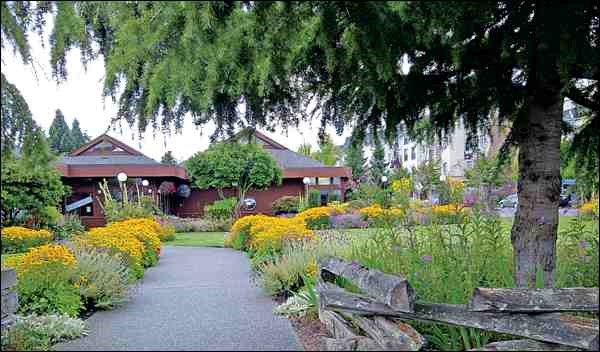This week I'm on vacation, spending time with my brother on Vancouver Island in Sidney, just north of Victoria. Of course I'm doing more than looking at gardens (e.g. spent an afternoon watching the Biggest Little Air Show, took in the Viking exhibition at the Royal B.C. Museum, enjoyed local brews and great food, and much more). But Victoria is the self-named City of Gardens and it's difficult to resist spending some time admiring the splendour that is only possible with a Mediterranean-like climate.
I expect most gardeners have heard of The Butchart Gardens, a site that has been wowing people since Jennie Butchart started transforming an abandoned limestone quarry over a 100 years ago to what is now a world-class attraction. But there are several other, lesser-known gardens in Victoria besides Butchart's that are worth visiting.
The first one I stopped at this week was the English Rose Garden beside the Empress Hotel on the shore of Victoria's Inner Harbour. There you'll see dozens of carefully tended tea roses in shades of red, pink, mauve, white and yellow. Not only will you be overwhelmed by the masses of colour, but when the air is still the perfume is nearly overpowering. This is not a large garden, but it has a big impact. Next to the garden is a large manicured lawn under the shade of trees, ideal for weddings and other social events. I assume you would have to arrange with the hotel to schedule a private event there; however, just wandering around the rose garden is free.
On nine acres, the Gardens at the Horticulture Centre of the Pacific (www.hcp.ca) started out as the Glendale Gardens in 1979. Not only is it a premier botanical garden, showcasing garden styles and over 10,000 varieties of plants suited for the Pacific Northwest, the HCP is also a teaching facility addressing industry training needs as well as those of amateur gardeners. There are over 30 distinct areas including the rhododendron, herb, winter, Mediterranean and ornamental grass gardens. I particularly enjoyed the tranquility of the Takata Japanese Gardens with its bridges, soothing sound of running water, seating for repose and reflection, and of course lush, beautiful plants. A new addition, the bonsai display garden, contains dozens of one to two foot tall trees like little leaf linden, ash, cedar and pine, some over 100 years old. While there, my brother and I enjoyed a healthy lunch at Nourish Bistro. The menu features gluten-free, dairy-free and vegan options. Open year-round, there is a daily entrance cost.
Another off-the-beaten-path garden is Finnerty Garden at the University of Victoria (http://www.uvic.ca/finnerty). Originally established on two acres in 1975 with the donation of 300 rhododendrons, it has grown to include more than 1,500 rhododendrons and azaleas on 6.5 acres. Complementing these are over 4,000 different mature trees, shrubs, perennials and ground covers, with ponds, grassy areas and benches all interconnected by a network of pathways. The site has been carefully planned to provide year-round interest with an ever-changing palette of scent, colour, texture and form. The best time to view the rhododendrons is in the spring. However, even in August there is much to see and the cool shade is a welcome relief from the heat. There is no cost to wander around this garden.
The City of Gardens spills over to Sidney. There is much to admire in the little seaside town and while the scale of public gardens may not compare to those found in Victoria, they are equally impressive including around humble public buildings like the local library. The garden there is well tended and contains both the familiar (rudbeckia, liatris, lamb's ears, roses, geranium) and the not-so familiar (lavender, seven-foot giant yellow coneflower, shrub hydrangea, rhododendron). And the familiar ones are larger and more vigorous versions of anything that can be grown on the Prairies due to the nearly yearlong, temperate growing season.
I'm here for another week with many more gardens to visit.
Have a gardening question? Contact GardenLine, 306-966-5865 or [email protected]
- This column is provided courtesy of the Saskatchewan Perennial Society (www.saskperennial.ca; [email protected]). Check out our Bulletin Board or Calendar for upcoming horticulture events (Labour&Learn at the Forestry Farm; garden tours).




